Ask any business owner what he or she needs, and you’ll likely hear “more customers.” Businesses can’t just rely on their existing customers to fuel growth, so there’s a constant need for more leads who will eventually become clients.
This guide will tell you how to use pay-per-click (PPC) advertising with Google Ads (formerly known as Google AdWords) to get more leads and grow your business.
Who PPC Lead Gen Works For
A common misperception is that PPC is only for e-commerce websites, but that’s not the case at all. PPC is a highly effective channel for websites and companies doing online lead generation.
Lead generation (often referred to as “lead gen”) is a requirement for businesses that can’t or won’t do business with just anyone. There’s usually a prequalification and information-exchange period that takes place so the company and consumer can make decisions based on information.
Lead-gen business characteristics might include:
- Trial periods
- Approval and denial processes
- Long sales cycles because of the complex nature of the product or service
- Price quotes
For example, financial services (credit cards and mortgages), all types of insurance, and business-to-business software survive with lead generation or lead capture. In fact, anyone who’s reading this guide is, or at some point has been, a lead for a company. As a lead you were categorized with a label, like “hot lead,” and were then marketed to on a regular basis until an event occurred: you may have signed up, were denied, decided to do nothing, or just went to the bottom of their lead pile to be marketed to later.
The goal of lead gen is to get prospects into the lead-tracking system (commonly depicted as a funnel – see below) to begin a contact period in which the company learns more about your needs and qualifications, and you learn more about the company’s products and services.
The ultimate goal is for a sales person to close the deal, so the company gains a new customer. It starts with obtaining basic information, like a name and email address, then progresses to getting more detailed information about the prospect.
Why PPC Is Great for Lead Gen
If you consider your typical lead funnel, it won’t take long to realize you need to keep filling the funnel full of leads.
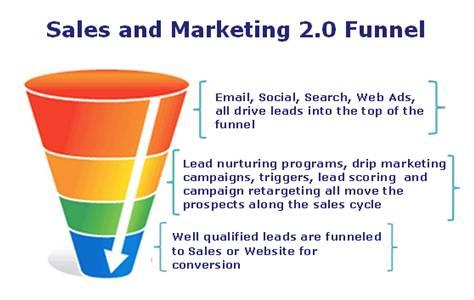
At first leads go into the top of the funnel, then work their way down to an eventual conversion. The challenge is getting the initial leads to feed the top of the funnel. Let’s look at the ways this may be accomplished and why PPC is an excellent source of leads:
- Blogging: This can be a good source of leads, but you need to a) constantly publish new content, b) hope your blog posts get shared a lot, and c) have a lot of blog subscribers. This takes time.
- Email: You can repeatedly email your existing subscribers, or you can rent or buy a list of email addresses and hope you’re targeting great new leads for your business.
- Social media: This can get you new followers and fans and expose you to new prospects. However, it doesn’t mean those followers are in your target market or need your product or service.
- Organic search: Organic ranking is the top of the heap. Approximately 85 percent of search clicks come from page one organic listings, and the clicks are free! The only problem is you’re competing with thousands of others for those positions, and you’ve got to do a ton of on- and off-page SEO work and wait months, maybe years, to get to page one.
- PPC: You can instantly appear on page one and be in front of people who are searching for your solution to their problem. More people are aware of you and what you have to offer than before. Bingo!
Yes, PPC is a channel you pay for by the click. Do keep in mind, though, that no marketing channel is free. Someone has to manage social media, write the blogs, work with the SEO agency (not free), and publish the emails—and those people don’t do it for free.
Benefits of PPC for Lead Generation:
- Attract visitors who are looking for what you offer
- Achieve immediate keyword rankings and traffic
- Bid on various stages of the funnel
- Control the message for each funnel stage
- See what people are searching for and craft your message to their needs
- Know more about your leads and their behavior
- Track ROI down to the penny
- Grow your database of leads and market to them with other methods
How Lead Gen Compares to E-Commerce
Back to our initial statement about how e-commerce and lead generation both use PPC marketing. The most glaring difference is the qualification process: in e-commerce, there is none. As long as you have a credit card you’re in the target market.
Lead gen vs. e-commerce ad copy
Starting with the ad copy itself, you’ll notice the messages and calls-to-action vary between e-commerce and lead-gen companies:

Notice how e-commerce is about immediate gratification (and sales!), while lead gen is a bit more discriminating. It’s rarely the case where you become an immediate customer in lead gen because you have to go through a process first.
Here are some real-world examples of how the ad copy, CTA, and landing page experiences compare. For lead gen, the keyword is “car insurance.”
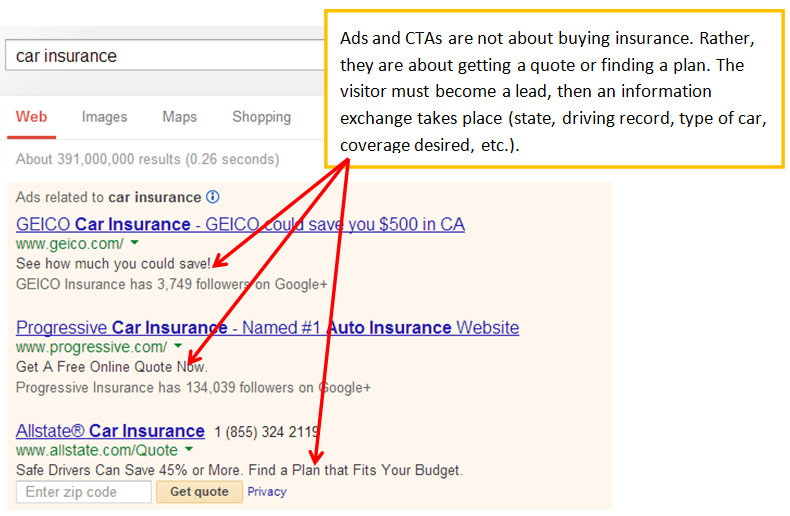
Now look at the e-commerce copy and CTAs used for “asics running shoes”:
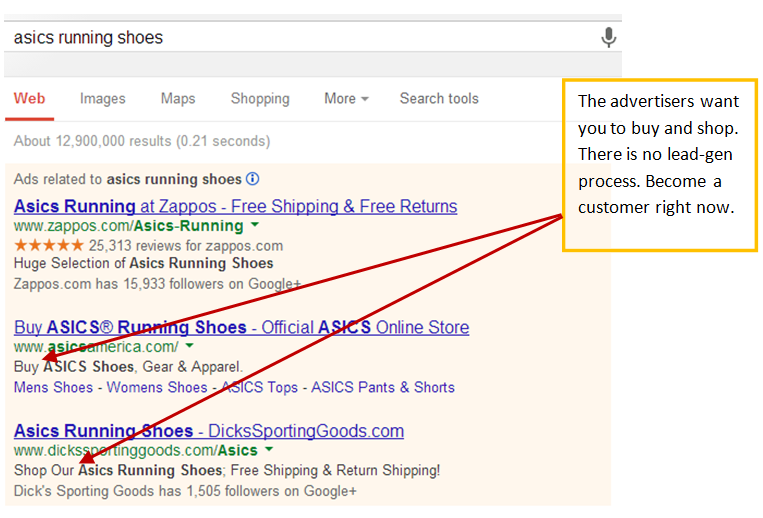
The ad copy and CTAs are somewhat subtle in their differences. The landing pages, however, are where a distinct difference between e-commerce and lead gen is clear.
Lead gen vs. e-commerce PPC landing pages
Here are some examples of lead-gen landing pages for PPC:
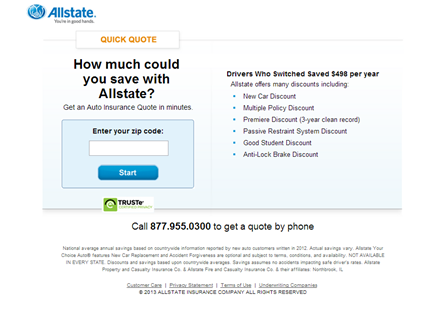

The landing pages are limited and with few distractions.
There’s a clear pattern of headline, benefits, and multiple calls-to-action: “Start,” “Get an online quote,” “Call,” etc.
Your choices are limited: either make a call or provide them with your zip code.
Visitors need to tell the companies more so the companies can start to qualify and route the leads through the funnel.
With e-commerce, it’s a different landing-page experience. Visitors are free to shop the stores and make purchases.
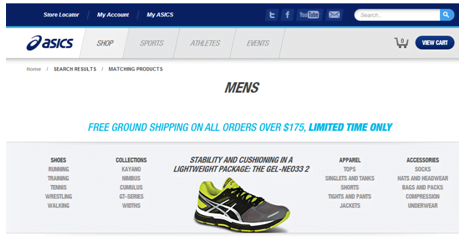
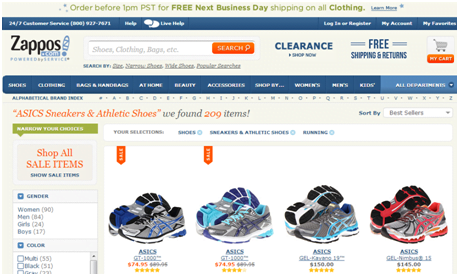
Both landing pages are relevant to the search query and provide additional pages to look at.
There’s urgency associated with the “free ground shipping” offer – it’s a limited time offer so visitors are motivated to purchase soon.
The theme of both landing pages is to shop now. They’re encouraging visitors to make purchases now.
How to Optimize Your Campaigns to Get More Leads Through PPC
Optimizing lead-gen campaigns with Google Ads requires the same principles you incorporate with e-commerce: tightly themed ad groups, testing ad copy and offers, and a variety of keywords. The major differences are the types of calls-to-action and the landing pages, as evidenced by the previous examples.
The goal is to keep topping off the funnel with qualified leads, and you do this by collecting information from your visitors. It’s a numbers game because not every click you get is going to convert, therefore you need to cast a wide net and increase your chances of getting qualified leads with PPC.
Actionable tips for improving your lead-gen performance:
Entice visitors with offers. Offer something (e.g., a free white paper or guide) in exchange for the visitor’s email, name, and more. At the very least, give them the opportunity to sign up for your blog or follow you on social media. Though the latter outcomes are not ideal, you at least have not wasted the click by getting nothing for it.
Use focused landing pages. Repeat the benefits and why the person should give you their information. Ask for just the right amount of pertinent information instead of making the transaction appear laborious by asking for too much information. Use primary and secondary CTAs. Test landing page length and fields. In short, make it as frictionless as possible.
Example of a PPC landing page that was reached via PPC:
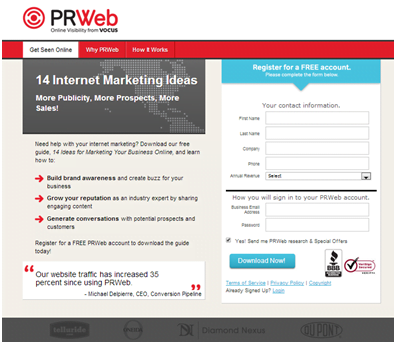
Things to notice:
- Very few fields to fill in = increased response
- Simple bullet point list of benefits
- Testimonial and short client list
- Free offer in exchange for information
- Trust and credibility proof
Try dynamic number insertion (DNI). DNI allows you to dynamically change the phone number that appears in your ads and on landing pages. This ensures your call representatives know what type of keyword triggered the call. You’re then better able to route calls to the right reps in your organization. Two of the better known providers are ifbyphone and Call Rail.
Invest in a solid CRM. Tracking your leads and staying in touch with them can become overwhelming—fast. A CRM (customer relationship management) program allows you to record who contacted you, what they were interested in, and what happened. You can then classify the leads you generated and engage with them via email or a phone call. There are tons of CRM companies out there, but some of the more popular ones are Infusionsoft, Zoho, and Salesforce.
Focus on a “new” KPI. In PPC we’re usually talking about metrics like cost-per-click and conversion rate. In lead gen, though, one of the major key performance indicators is cost-per-lead (CPL). It’s simple to calculate: [Overall cost of PPC campaign / number of leads = CPL]. In short, it will reveal how much you’re paying for your leads and will drive your decision-making process.







